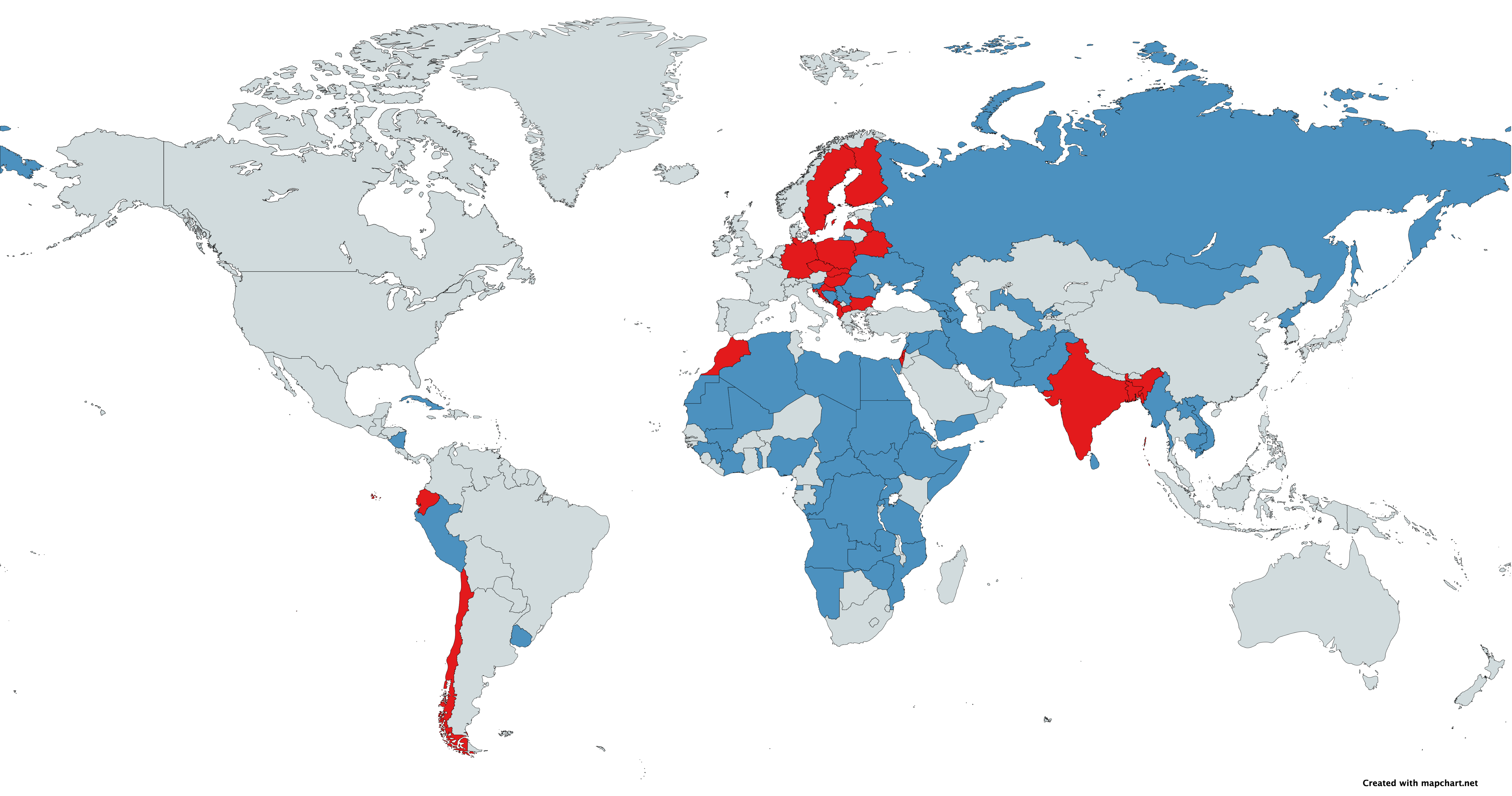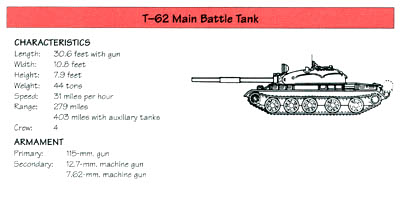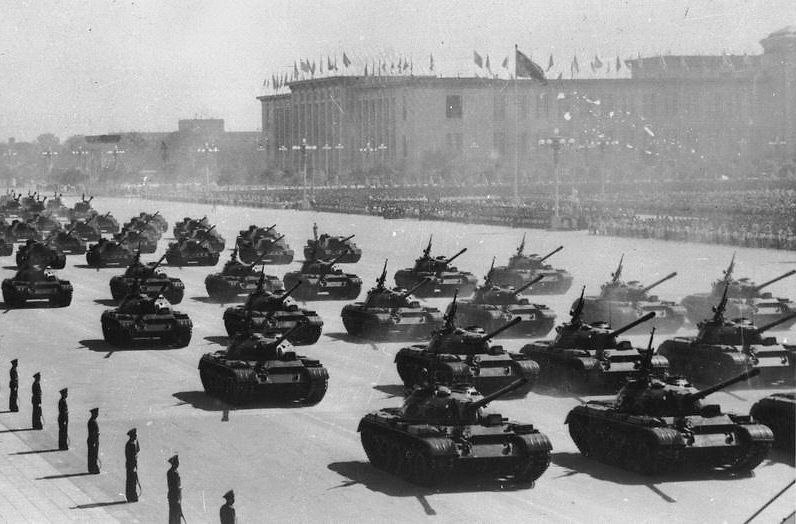|
T-55
The T-54 and T-55 tanks are a series of Soviet medium tanks introduced in the years following the Second World War. The first T-54 prototype was completed at Nizhny Tagil by the end of 1945.Steven Zaloga, T-54 and T-55 Main Battle Tanks 1944–2004, p. 6 From the late 1950s, the T-54 eventually became the main tank for armoured units of the Soviet Army, armies of the Warsaw Pact countries, and many others. T-54s and T-55s have been involved in many of the world's armed conflicts since their introduction in the second half of the 20th century. The T-54/55 series is the most-produced tank in history. Estimated production numbers for the series range from 96,500 to 100,000. They were replaced by the T-62, T-64, T-72, T-80 and T-90 tanks in Soviet and Russian armies, but are still used by up to 50 other armies worldwide, some having received sophisticated retrofitting. The Chinese version of the T-54A is the Type 59. During the Cold War, Soviet tanks never directly faced their NA ... [...More Info...] [...Related Items...] OR: [Wikipedia] [Google] [Baidu] |
T-54/T-55 Operators And Variants
The T-54/T-55 tank series is the most widely used tank in the world and has seen service in over 50 countries. It has also served as the platform for a wide variety of specialty armoured vehicles.Miller, David ''The great Book of Tanks'' Salamander Books London, England 2002 338-341 Halberstadt, Hans ''Inside the Great Tanks'' The Crowood Press Ltd. Wiltshire, England 1997 94-96 Current operators * : A number of T-55s were in service at the beginning of the 1992 and 1993 War in Abkhazia. These were all lost in the first four months of the fighting, at which point Abkhazian forces had captured 8 T-55s from the Georgians. At peak strength, there were 100 T-55s and T-72s in service. More than 50 T-55s and T-72s were in service in 2004. 87 T-55s and T-72s were in service before the 2008 South Ossetia war. Between 50 and 60 T-55s and T-72s are currently in service. * : 50 T-54s and 50 T-55s were ordered in 1961 from the Soviet Union and delivered between 1962 and 1964 (T-54s were ... [...More Info...] [...Related Items...] OR: [Wikipedia] [Google] [Baidu] |
T-62
The T-62 is a Soviet main battle tank that was first introduced in 1961. As a further development of the T-55 series, the T-62 retained many similar design elements of its predecessor including low profile and thick turret armour. In contrast with previous tanks, which were armed with rifled tank guns, the T-62 was the first production tank armed with a smoothbore tank gun which could fire APFSDS rounds at higher velocities (the U.S. prototype T95 medium tank was the first tank ever built with a smoothbore gun). While the T-62 became the standard tank in the Soviet arsenal, it did not fully replace the T-55 in export markets due to its higher manufacturing costs and maintenance requirements compared to its predecessor. Although it was followed by later models in successor states of the Soviet Union, the T-62 remains in reserve in some countries formerly part of the USSR and in frontline use by other countries. Design features of the T-62 became standardized in subseque ... [...More Info...] [...Related Items...] OR: [Wikipedia] [Google] [Baidu] |
D-10 Tank Gun
The D-10 is a Soviet 100 mm tank gun developed in late World War II. It originally equipped the SU-100 tank destroyers and was later selected for the T-55 tank, equipping these as late as 1979. On the T-55 the D-10 continues to be in active service in many countries. History At the beginning of 1944, the T-34 tank's F-34 76.2 mm tank gun was replaced by a more powerful 85 mm gun. This rendered the year-old SU-85 tank destroyer effectively obsolescent, since its D-5T 85 mm gun was now also fielded by a more flexible medium tank. F. F. Petrov's Design Bureau at Artillery Factory No. 9 was assigned the task of producing a 100 mm anti-tank gun that could be used on the SU-85 chassis, for the proposed SU-100. To achieve this goal, Petrov's team modified the S-34 naval gun for use in an armoured fighting vehicle. The D-10 is a high-velocity gun of 100 mm calibre (bore diameter), with a barrel length of 53.5 calibres. A muzzle velocity of 895 m/ ... [...More Info...] [...Related Items...] OR: [Wikipedia] [Google] [Baidu] |
Type 59 Tank
The Type 59 (; industrial designation: WZ-120) main battle tank is a Chinese-produced version of the Soviet T-54A tank, an early model of the ubiquitous T-54/55 series. The first vehicles were produced in 1958 and it was accepted into service in 1959, with serial production beginning in 1963. Over 9,500 of the tanks were produced by the time production ended in 1985 with approximately 5,500 serving with the Chinese armed forces. The tank formed the backbone of the Chinese People's Liberation Army armoured units until the early 2000s, with an estimated 5,000 of the later Type 59-I and Type 59-II variants in service in 2002. The Type 59 was modified several times during its service. It was also the basis of several later Chinese tank designs including the Type 69 and Type 79 tanks. Description The Type 59 is almost identical to the early production Soviet T-54As, but there are some key differences. The Type 59 was not originally fitted with the infrared searchlight or main g ... [...More Info...] [...Related Items...] OR: [Wikipedia] [Google] [Baidu] |
T-64
The T-64 is a Soviet tank manufactured in Kharkiv, and designed by Alexander Morozov. The tank was introduced in the early 1960s. It was a more advanced counterpart to the T-62: the T-64 served in tank divisions, while the T-62 supported infantry in motor rifle divisions. It introduced advanced features including composite armour, a compact engine and transmission, and a smoothbore 125-mm gun equipped with an autoloader to allow the crew to be reduced to three so the tank could be smaller and lighter. In spite of being armed and armoured like a heavy tank, the T-64 weighed only . These features made the T-64 expensive to build, significantly more so than previous generations of Soviet tanks. This was especially true of the power plant, which was time-consuming to build and cost twice as much as more conventional designs. Several proposals were made to improve the T-64 with new engines, but chief designer Alexander Alexandrovich Morozov's political power in Moscow kept t ... [...More Info...] [...Related Items...] OR: [Wikipedia] [Google] [Baidu] |
Kharkiv Morozov Machine Building Design Bureau
Kharkiv Morozov Machine Building Design Bureau (), often simply called Morozov Design Bureau or abbreviated KMDB, is a state-owned Ukrainian company in Kharkiv which designs armoured vehicles, including the T-80UD and T-84 main battle tanks, as well as military prime movers. It was responsible for designing and creating many important Soviet-era armoured fighting vehicles, including the BT tank series, with its most famous designs being the T-34, T-54, and T-64 tanks. It is closely associated with the Malyshev Factory. History KMDB started as the Tank Design Team of the Kharkiv Locomotive Factory ''Komintern'' (KhPZ, now Malyshev Factory) in 1927, in Kharkiv, Ukrainian Soviet Socialist Republic, and was responsible for the T-12 and T-24 light tanks. In the 1930s, the design team was designated as the independent T2K Tank Design Bureau, and began work on the BT tank series. In 1936 the plant was re-designated "Plant No. 183", and the design bureau "KB-190". The plant also ... [...More Info...] [...Related Items...] OR: [Wikipedia] [Google] [Baidu] |
Kharkiv Model V-2
The Kharkiv model V-2 () is a Soviet and Russian family of diesel tank V-12 engines, the V angle at 60°, with dual overhead camshafts per bank, four valves per cylinder opened by bucket-style followers and direct fuel injection. Designed at the Kharkiv Locomotive Factory by Konstantin Chelpan and his team, it is found in the BT-7M (BT-8), T-34, KV, IS and IS-10 (T-10) tanks, and by extension, the vehicles based on them, such as the SU-85 and SU-100 tank destroyers based on the T-34 and the ISU-122 and ISU-152 self-propelled guns based on the IS-2. Throughout its production life, output ranged from roughly . Successive variants of the V-2 have been used in multiple Soviet and Russian vehicles ever since. Heavily modernised derivatives of the V-2 remain in production, with the T-90A tank, Koalitsiya-SV self-propelled gun and BMPT Terminator armoured support vehicle equipped with a 1,000 hp V92S2, while the latest T-72B3 and T-90M tanks feature an upgraded 1,130 ... [...More Info...] [...Related Items...] OR: [Wikipedia] [Google] [Baidu] |
T-72
The T-72 is a family of Soviet Union, Soviet main battle tanks that entered production in 1973. The T-72 was a development based on the T-64 using thought and design of the previous Object 167M. About 25,000 T-72 tanks have been built, and refurbishment has enabled many to remain in service for decades. It has been widely exported and has seen service in 40 countries and in numerous conflicts. The Russian T-90 introduced in 1992 and the Chinese Type 99 tank, Type 99 are further developments of the T-72. Production and development of various modernized T-72 models continues today. Development Development from the T-64 The T-72 was a product of a rivalry between design teams. Kharkiv Morozov Machine Building Design Bureau, Morozov KB was led by Alexander Alexandrovich Morozov, Alexander Morozov in Kharkiv. Uralvagonzavod, Uralvagon KB was led by Leonid Kartsev in Nizhny Tagil. To improve on the T-62, two designs based on the tank were tested in 1964: Nizhny Tagil's Object 167 (T- ... [...More Info...] [...Related Items...] OR: [Wikipedia] [Google] [Baidu] |
DShK
The DShK M1938 (Cyrillic: ДШК, for ) is a Soviet heavy machine gun. The weapon may be vehicle mounted or used on a tripod or wheeled carriage as a heavy infantry machine gun. The DShK's name is derived from its original designer, Vasily Degtyaryov, and Georgi Shpagin, who later improved the cartridge feed mechanism. It is sometimes nicknamed Dushka (a dear or beloved person) in Russian-speaking countries, from the abbreviation. Specifications The DShK is a belt-fed machine gun firing the 12.7×108mm cartridge, and uses a butterfly trigger. Firing at 600 rounds per minute, it has an effective range of , and can penetrate up to 20 mm of armor up to a range of 500 m. The DShK has two "spider web" ring sights for use against aircraft. It is used by infantry on tripod mounts or deployed with a two-wheeled mounting and a single-sheet armor-plate shield. It is also mounted on tanks and armored vehicles for use against infantry and aircraft; nearly all Soviet-designed tan ... [...More Info...] [...Related Items...] OR: [Wikipedia] [Google] [Baidu] |
Main Battle Tank
A main battle tank (MBT), also known as a battle tank or universal tank or simply tank,Ogorkiewicz 2018 p222 is a tank that fills the role of armour-protected direct fire and maneuver in many modern armies. Cold War-era development of more powerful engines, better suspension systems and lighter composite armour allowed for the design of a tank that had the firepower of a super-heavy tank, the armour protection of a heavy tank, and the mobility of a light tank, in a package with the weight of a medium tank. The first ''designated'' MBT was the British Chieftain (tank), Chieftain tank, which during its development in the 1950s was re-designed as an MBT. Throughout the 1960s and 1970s, the MBT replaced almost all other types of tanks, leaving only some specialist roles to be filled by lighter designs or other types of armoured fighting vehicles. Main battle tanks are a key component of modern armies.Main battle tank#House1984, House (1984), ''Toward Combined Arms Warfare: A Surve ... [...More Info...] [...Related Items...] OR: [Wikipedia] [Google] [Baidu] |
Malyshev Factory
The Malyshev Factory (; abbreviated ), formerly the Kharkov Locomotive Factory (, ), is a state-owned manufacturer of heavy equipment in Kharkiv, Ukraine. It was named after the Soviet politician Vyacheslav Malyshev. The factory is part of the state concern, Ukroboronprom. It produces diesel engines, farm machinery, coal mining, sugar refining, and wind farm equipment, but is best known for its production of Soviet tanks, including the BT tank series of fast tanks, the famous T-34 of the Second World War, the Cold War T-64 and T-80, and their modern Ukrainian successor, the T-84. The factory is closely associated with the Morozov Design Bureau (KMDB), designer of military armoured fighting vehicles and the Kharkiv Engine Design Bureau (KEDB) for engines. In 1958, it developed the Kharkovchanka, an off-road vehicle which reached the South Pole the following year. At its height during the Soviet era, the factory employed 60,000 of Kharkiv's 1.5 million inhabitants. , 5,00 ... [...More Info...] [...Related Items...] OR: [Wikipedia] [Google] [Baidu] |
Uralvagonzavod
UralVagonZavod () is a Russian machine-building company located in Nizhny Tagil, Russia. It is one of the largest scientific and industrial complexes in Russia and the largest main battle tank manufacturer in the world. Etymology The name ''Уралвагонзавод'' means ''Ural Railroad Car (wagon) Factory''. History The plant was built during 1931–1936, mostly during the second Five-year plans of the Soviet Union, Soviet five-year plan. It opened on October 11, 1936, and was named after Felix Dzerzhinsky. Initially it manufactured freight cars. After the Operation Barbarossa, German invasion of 1941, Joseph Stalin ordered hundreds of factories in Ukraine and western Russia to be evacuated east. The KhPZ Factory No. 183 in Kharkiv was moved to Nizhny Tagil by rail, and merged with the Dzerzhinsky Works, to form the Stalin Ural Tank Factory No. 183. During the Second World War it became the largest producer of tanks in the world, including the T-34. For its services, U ... [...More Info...] [...Related Items...] OR: [Wikipedia] [Google] [Baidu] |











